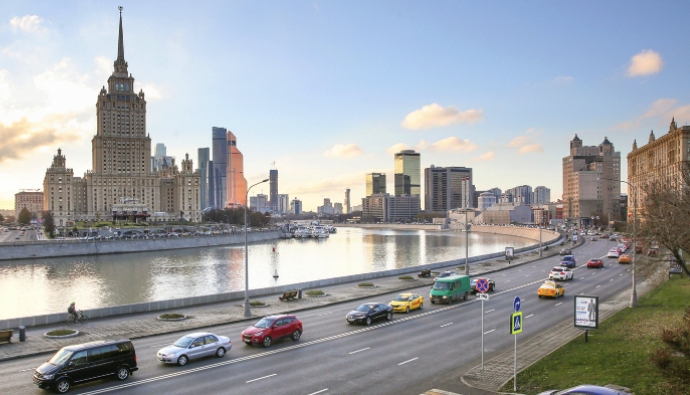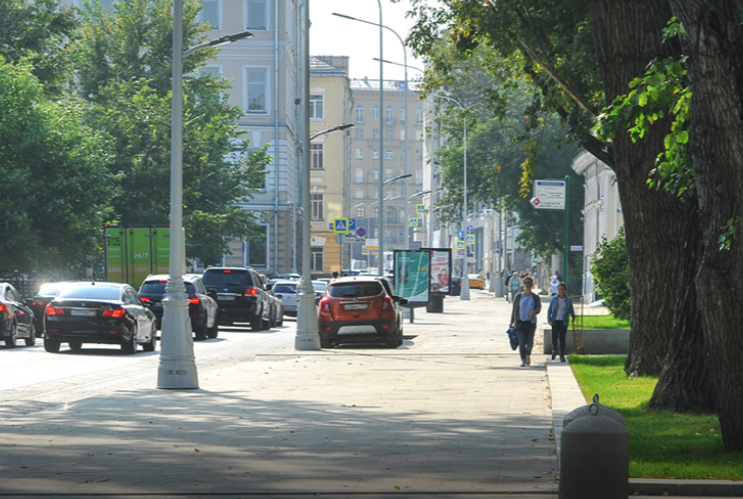Rings and parks of 2017: no fashion, just improvements

Moscow improved 119 streets, squares, embankments, motorways and other urban areas in 2017. Below are some of the most beautiful.

Garden Ring
This year, the improvement effort covered a 12-km section of the Garden Ring from Dolgorukovskaya Street to Smolenskaya Square. The areas that received a facelift included, among others, the Korovy Val, Zhitnaya Street, Valovaya, and Zemlyanoi Val and Krymsky Val streets, and the Serpukhovskaya, Sukharevskaya, Taganskaya squares. Pavements were significantly widened, cables were put underground, new streetlamps were installed, lawns were planted, and over 130 facades were repaired. Trees are being planted on the Garden Ring.
The Valovaya Street and Serpukhovskaya Square improvement focused on creating a people-friendly and safe pedestrian space. Lawns and a line of bushes and trees were planted to separate sidewalks from the traffic, which was not affected. Wider pavements were the result of the optimization of the road width, not a simple reduction in the number of lanes.
Valovaya Street was built in 1816-1820 after the demolition of Zemlyanoi Val. Similar to other streets in Zamoskvorechye, gardens were planted to change the name of the street from Valovaya to Sadovaya (Garden). In the 19th century, the street was repeatedly included in and excluded from Zatsepsky Val. It was only in early 20th century that the two streets acquired their present-day boundaries.
This year, Krasnyye Vorota Square was renovated as well. Cables were relocated underground, and grass was planted. The square finally lives up to its name since Krasnyye originally meant ‘beautiful’ in Russian. The name was initially unofficial. In 1709, a triumphal arch was built on the site of the Zemlyanoi Val gates to mark the return of the victorious Russian army from the battle of Poltava. The arch was called the Triumphal Gate on Myasnitskaya Street by Zemlyanoi Gorod. Ordinary Muscovites liked it so much that they called it ‘krasnyye.’ Gradually, the name was officially adopted.
The Garden Ring celebrates its 425th anniversary this year. It began as a defence line, the fourth from the Kremlin, in the late 16th century. It was the city boundary at the time, and Boris Godunov ordered that it be fortified. Ramparts were then made and oak walls with towers were built above them. A water-filled fosse was dug in front. The defences were completed in just a year (1591-1592). Fast even by today’s standards, for contemporaries of the time, this achievement was a miracle. They construction was called Derevyanny or Zemlyanoi Gorod officially, but Muscovites nicknamed it Skorodom, Fast-House.

Boulevard Ring
2017 saw the improvement of the Boulevard Ring. Improvements included, for example, Gogolevsky, Strastnoi, Pokrovsky and Chistoprudny boulevards.
The 9-km ring is comprised of 10 boulevards with numerous squares between them. Unlike the Garden Ring, the Boulevard Ring is hardly a ring at all, more resembling a horseshoe. Its continuity is broken by Prechistenskiye Vorota Square by the Christ the Saviour Cathedral in the west, and by Yauzkiye Vorota Square in the east.
This used to be the third defence line after the Kremlin and Kitai-Gorod. In 1571, a Crimean Tatar raid led to the wooden fortifications burning down. They were replaced by a wall of stone 20 years later. Muscovites knew it as the Wall of Bely Gorod, ‘the White City.’ In two centuries the wall lost its purpose and was demolished. Still, it was made of top-quality stone that was later used to build both housing and public buildings such as the Emperor’s Founding Home.
Luckily, parts of the wall survived. One section, 64 metres long, was discovered during a construction on Khokhlovskaya Square. It was recognised as a federal monument and preserved in 2008. In 2016, the future of the monument was at last decided: it was to become part of a museum display. The project was implemented this year with Khokhlovskaya Square becoming an archaeology park where visitors can take a glimpse at ancient Moscow.

Embankments and pedestrian streets
Improving areas close to the water was a priority this year. Twelve Moscow embankments received facelifts. They are now home to people-friendly pedestrian spaces, green areas and vista points. The pavements were widened to welcome cyclists and strollers alike and include some leisure spots. As a result, the embankments are becoming new centre of attraction for those who want to skate, skateboard, cycle, dance, run or to simply take a walk.
Part of the Yakimanskaya Embankment from 3rd Golutvinsky Pereulok to Bolshaya Yakimanka Street was pedestrianised to become a natural extension of the Krymskaya Embankment, which is completely off-limits to traffic.
Sidewalks in the Yakimanskaya Embankment are over 10 metres wide. Between the Patriarshy Bridge and the Maly Kamenny Bridge you can now take a pleasant stroll towards Balchug, Bolshaya Polyanka Street and along the Vodootvodny Channel.
Other renovated embankments include Krasnopresnenskaya, Rostovskaya, Smolenskaya, Savvinskaya, Bolotnaya, Kotelnicheskaya, Goncharnaya, Luzhnetskaya, Prechistenskaya, Moskvoretskaya and Andreyevskaya. Improvement projects are specific. Vista points were set up on the Krasnopresnenskaya and Andreyevskaya embankments, while the Rostovskaya got a slope and an original lightning scheme. There are similarities, however. Sidewalks have been widened and trees planted on all the embankments to separate traffic and walkers.
Moscow has been transformed in recent years. More pedestrian spaces are one of the more pleasant developments. On some streets the pavements were widened while other streets were closed to traffic altogether. For instance, this year the city has fully pedestrianised Rybny Pereulok, Bogoyavlensky Pereulok and 3rd Golutvinsky Pereulok.
Walking from the Ploshchad Revolyutsii metro station through Rybny Pereulok and Bogoyavlensky Pereulok is the shortest and now the most pleasant way to reach the new Zaryadye Park. City estimates put the number of people passing here at 100,000 each day. This capacity will play a big role during national holidays.

Parks, lightning and a little bit of archaeology
Every year, Moscow builds new parks and updates old parks and square parks. The last items on the eco-friendly list are the The 850th Anniversary of Moscow Park, Festivalny Park and Akademichesky Park. The first two opened after improvement efforts, the last was built from scratch. The 850th Anniversary of Moscow Park has a five-kilometre cycling track, a climbing wall and a pump track for extreme cycling. There are also two football pitches, fitness areas, and a workout station. Festivalny Park is more suited for people who enjoy calmer kinds of recreation and strolls, although there are opportunities to stay fit as well at tennis, streetball and volleyball courts. Ski tracks will be cleared in the park during the winter.
Akademichesky Park also offers visitors a choice between more active and less active recreation. There are pathways with gazebos and benches, three fitness areas, a football pitch, a basketball court and a workout area. Large dinosaur figures near the entrance are a reminder that the park is located not far from the Darwin Museum.
It is important to show beauty in the right light, not simply create it. Hundreds of Moscow buildings, bridges and interchanges are embellished with artistic lighting. This form of illumination can be seen on Maroseika, Pokrovka, Myasnitskaya, Volkhonka and dozens of other streets. And it is not limited to the city centre with Moscow entry (major radial) motorways also punctuated by special light effects.
Tverskaya Street and 1st Tverskaya-Yamskaya Street are no exception. White light makes the magnificent buildings that line these streets stand out even more. Streetlamps were also replaced. New ones feature energy-saving bulbs. Tverskaya Zastava Square, which was also renovated this year, now uses copies of its original lamps, which were recreated with historical drawings.



